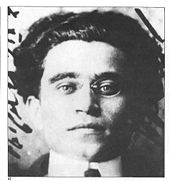Passive revolution

Passive revolutionis a transformation of the political and institutional structures without strong social processes by ruling classes for their own self-preservation. The phrase was coined by theMarxistpolitician and philosopherAntonio Gramsciduring theinterwar periodin Italy.
Gramsci's use of the term[edit]
Passive revolution describes a gradual but continuous reorganization of the state and economy in order to preserve the power of the elite by incorporating or neutralizing the power of adversarial groups through transforming them into partners, all without overcoming the fundamental social contradictions.[1]Gramsci argued that when a social group lacks the strength to establishhegemony,it will instead choose a path where its interests and demands will "be satisfied by small doses, legally, in a reformist manner-- in such a way that it was possible to preserve the political and economic positions of the old ruling class."[1]This "avoid[s] the popular masses going through a period of political experience such as occurred in France in the years ofJacobinism."[1]
Gramsci uses "passive revolution" in a variety of contexts with slightly different meanings. The primary usage is to contrast the passive transformation ofbourgeoissociety in 19th-century Italy with the active revolutionary process of the bourgeoisie in France. Whereas the French case is seen by Gramsci as an authentic revolution guided by social forces, the Italian case was 'elite-driven'; a process of modernization that did not disrupt the social arrangements of power in Italy but instead modernized it on the behalf of elite classes to secure their own position. The change described is not abrupt but a slow and gradualmetamorphosisthat may take years or generations to accomplish.[2]
In addition to his comparison of the French Revolution versus the Italian case, Gramsci also associatesItalian fascismwith the notion of passive revolution.[citation needed]
Gramsci also used the term for the mutations of the structures ofcapitalisteconomic production that he recognized primarily in the development of the US factory system of the 1920s and 1930s. Passive revolution is detailed by Gramsci as an elite process of state restructuring in Italy specifically, but it has been used as a frame of analysis for viewing other transitions to capitalist modernity.[3]
Usage since Gramsci[edit]
'Passive revolution has been characterized by the quote from Prince Don Fabrizio Corbera of Salina inGiuseppe Tomasi di Lampedusa’s novelIl Gattopardo:‘Everything must change so that everything can remain the same’.[4]
Professor Yiching Wu writes that China's post-Mao reforms were an example of passive revolution.[1]TheChinese Communist PartyunderDeng Xiaopingcoped with socioeconomic woes through consolidating its power, using market mechanisms and commodification to create controlled openings "to buy precious time in relation to both global capitalist competition and domestic popular discontent."[1]Through the "passive revolution" of the reforms, party bureaucrats and intellectuals created a new technocratic elite that won the support of rural peasants who wanted personal control of land and urban people who wanted more consumer goods and a higher living standard.[1]
See also[edit]
References[edit]
- ^abcdefWu, Yiching (2014).The Cultural Revolution at the Margins: Chinese Socialism in Crisis.Cambridge, Mass.:Harvard University Press.pp. 220–221.doi:10.4159/harvard.9780674419858.ISBN978-0-674-41985-8.OCLC881183403.
- ^Gramsci, Antonio; Forgacs, David (1988).An Antonio Gramsci Reader: Selected Writings, 1916-1935.New York: Schocken.
- ^Morton, Adam David (September 2007). "Waiting for Gramsci: State Formation, Passive Revolution and the International".Millennium: Journal of International Studies.35(3): 597–621.doi:10.1177/03058298070350031301.ISSN0305-8298.S2CID143460055.
- ^Cox, Robert W. (October 2007). "Unravelling Gramsci: Hegemony and Passive Revolution in the Global Political Economy".Capital & Class.31(3): 258–261.doi:10.1177/030981680709300116.ISSN0309-8168.S2CID152363012.
Further reading[edit]
- Gramsci, Antonio; Forgacs, David (1988).An Antonio Gramsci Reader: Selected Writings, 1916–1935.New York: Schocken.
